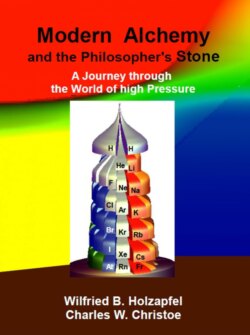Читать книгу Modern Alchemy and the Philosopher's Stone - Wilfried B. Holzapfel - Страница 24
На сайте Литреса книга снята с продажи.
Оглавление“Some of these shapes are still relevant to what I mean when I use the term modern alchemy today – but in a somewhat different way,” the professor was saying. He picked up one of the models that Helen had just noticed. It was an assembly of magnetic steel balls that had assumed a solid shape by their attraction to each other.
“Look at how closely the spheres in this model are packed together.” The professor was rotating the model in his hands just as her high-school chemistry teacher had done.
The professor continued his presentation. “If you divide the space around the balls evenly with respect to each of its neighbors, you create a regular body with twelve identical faces. That twelve-sided space is repeated throughout the solid. You can see that, if you then select the same number of balls to represent each edge of the model, the emerging body is called a rhombic dodecahedron. That is because this body has 12 identical rhombic outer surfaces.”
Helen recalled that a rhombus is like a square that has been pushed over at the top. All four sides have equal length, but none of the angles are ninety degrees. The professor referred back to the drawing (Figure 9) of the model that he was holding. The rhombic dodecahedron appeared on the right-hand side of the picture. Helen’s fears had become reality. She could see in the figure on the right that, even though all of the rhombuses in a three-dimensional solid were identical, they all appeared different in this two-dimensional drawing.
The professor continued. “Although this particular solid form does not happen to be one of the beautiful Platonic solids, you can imagine an array of these units next to each other, completely filling a volume of space. The result would be a piece of material that you could actually hold in your hand. It is possible for scientists to create materials like that by carefully controlling the environment of a solution that contains ions or molecules. We call that process “growing a crystal.” In this case, the crystal that you hold in your hand could have the same symmetry properties as the close packing model, like the one with the steel balls. Perfectly grown crystals are always made up of such small regular units.
“Since I want to explain more about the United States of the Elements, I want to focus on crystals that contain only one kind of atom. Crystals made up of only one element often take this form of dense packing.
“Diamond is an example of a material that is made up of only one kind of atom with covalent bonds between the adjacent carbon atoms.” The professor took another photograph from the stack (Figure 10). This time the model looked more like some of the other ones on the shelf. It was not a solid bundle of steel balls but an actual latticework of little wooden balls connected by wire rods.
